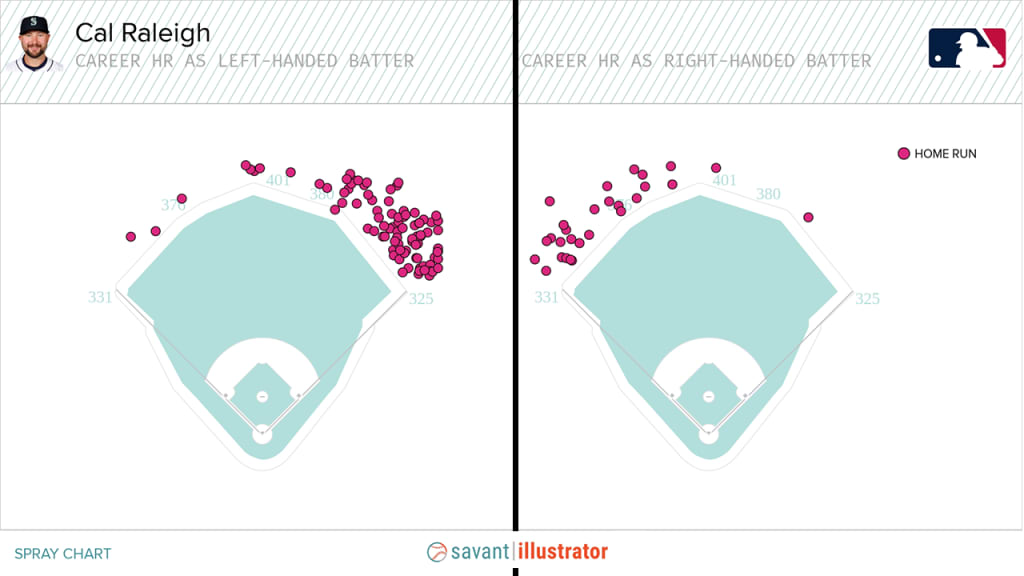Mariners catcher Cal Raleigh is off to a phenomenal slugging start.
He entered Friday's game against the Guardians -- not even halfway through June -- with an MLB-best 26 home runs, which, combined with his Platinum Glove defense, might end up having him in the conversation for one of the best seasons a catcher’s ever had. While he’s certainly going to make the All-Star Game and likely get some notice in the Most Valuable Player race, that’s not the thing that’s drawing our attention right now.
It’s this: Raleigh began Friday on pace for 63 homers. Sixty-three. More than Aaron Judge. More than anyone.
He almost certainly won’t get to 63, of course, because “on pace for” implies that exactly what has happened will continue to happen exactly the same, which is unlikely for any player, and yet: He’s taken nearly 300 plate appearances and he’s still on pace for 63 homers. It’s early, but it’s not that early; the Mariners have played more than 40% of their schedule.
Even if he doesn’t quite end up at that level, there are other targets in mind. Season home run records for Mariners (56) or switch-hitters (54) or catchers (48) or switch-hitting catchers (41) all remain within reach.
Raleigh plays in a near-historically bad park for hitters, and he plays the most demanding physical position on the field. How’s he doing it? By applying the hitting advice of maybe the most gifted hitter who ever lived to his own considerable natural strengths, as well as the most modern thinking that up-and-comers are trying to get to.
Rather than just get right to the numbers – though we will – we thought it best to do this by sharing four very different baseball quotes that all describe a little something about what’s happening here. (All numbers below are entering Friday.)
1. “You got a catcher that’s the best catcher in the history of the game his first three years.”
That one was from Justin Turner this spring. Turner, now with the Cubs, spent the last two months of 2024 as Raleigh’s Seattle teammate after being traded from Toronto last July.
Now: Raleigh isn’t really the “best catcher in the history of the game his first [four, actually, despite Turner saying three] years,” because that was Johnny Bench, in terms of overall value. What Turner is referring to is that Raleigh’s 93 homers in his first four seasons topped Mike Piazza’s 92 for the most from a catcher. Should we overthink it that Piazza lost a big chunk of his 1994 season because the season ended in August? We shall not.
The takeaway there is simple enough: while this might be Raleigh’s career year, it’s not exactly an out-of-nowhere power surge, either.
2. “It’s definitely hard to hit here. … At the end of the day, you probably get a little less bang for your buck, I guess is probably the best way to describe it.”
That’s longtime Mariners utilityman Dylan Moore to MLB.com last winter, when we went deep – really deep – on just how extreme of a pitcher’s park Seattle’s T-Mobile Park really is. Moore should know; over his career, he’s been productive on the road (.771 OPS) and miserable at home (.628 OPS). It’s been an absolutely brutal place to hit for more than two decades.
Raleigh, like everyone else, was affected last year, when he hit .201 with a .665 OPS at home against a .237 average and .823 on the road, hitting more than twice as many home runs away from Seattle (23) as he did at T-Mobile Park (11).
It’s a huge barrier for any hitter. Nothing’s really changed this year: Mariners hitters have an OPS almost exactly 100 points lower at home so far this season.
Except … Raleigh has figured out a way around it, at least so far. His 26 homers are split evenly home and away. If he’s still a better hitter on the road (1.018 OPS), then it’s really not by very much more than what he’s doing at home (.980). That both of those numbers are much-improved over last year tells you that it’s more about Raleigh as a whole than Seattle-specific, but as far as “get[ting] less bang for your buck,” as Moore aptly said … well, Raleigh’s getting plenty of bang.
3. “The toughest thing is to pull the ball and get it in the air. That's the premium, par excellence hit.”
It’s one thing to hear contemporaries speak. This one is from none other than Ted Williams himself, explaining his views on hitting to Wade Boggs and Don Mattingly in a memorable 1986 Sports Illustrated roundtable captured by Peter Gammons. If it’s good enough for Ted, it’s good enough for us, and hitters are starting to take notice; the pull-in-the-air rate has risen slowly but steadily over the years.
It’s not, we readily admit, for everyone. Slap hitters probably don’t want to be selling out for power all the time. But if you’ve got some pop? It’s incredibly effective. Pulling the ball not only helps you find a shorter path to the seats than center field or the alleys, but it helps you make contact at the fastest part of your swing, by as much as +4 mph.
Would you be surprised to learn this? No one is doing this as often as Raleigh.
Pull air % leaders, 2025
- 39% // Raleigh
- 35% // Rhys Hoskins
- 35% // Isaac Paredes
- 33% // Andrew Benintendi
- 32% // Spencer Torkelson
- 31% // Danny Jansen
- 31% // Anthony Santander
- 30% // Pete Crow-Armstrong
- 30% // Alex Bregman
There’s more than one way to succeed -- you’ll find James Wood and Christian Yelich near the other end -- but this tells you a lot about how Torkelson, Crow-Armstrong and Bregman are having such strong seasons.
For Raleigh, it’s a massive increase over the 29% he had last year. When he does this, for his career, he ends up with a .588 average and a 1.528 slugging percentage. “Do it more” is obviously easier said than done, but as Williams said: the premium, par excellence hit. Why wouldn’t you want it more?
And when we say more, we do mean “more.” Going back to 2008, there are more than 6,000 seasons where a batter had at least 100 batted balls, and only one of them had a higher pulled-air rate than what Raleigh’s doing this year. That was two years ago, when Adam Duvall sold out for a massive 45% pulled-air rate -- and hit 21 homers with an .834 OPS in 92 games for Boston.

If you only care about pulling the ball in the air with hard contact, which is really the point, then Raleigh’s in the top 10, with a number of Joey Gallo seasons ahead of him. “What if Joey Gallo cooled it with the strikeouts a little and was also an excellent defensive catcher” is a pretty fun question to ask.
4. “You make your money when you hit the ball out front. That’s where you’re going to produce more damage, more power.”
That was Twins prospect Walker Jenkins to FanGraphs this spring. Jenkins, the No. 5 pick in the 2022 Draft, and currently MLB Pipeline’s No. 6 overall prospect, is espousing a strategy that might have been hearsay a decade ago before hitters like Turner, J.D. Martinez and Josh Donaldson helped change how many hitters thought.
We bring this one up because earlier this year, Statcast released new bat tracking metrics about where each hitter’s point of contact is, and wouldn’t you know it: Over the last two seasons, no righty hitter is making contact further out front of his center of mass than Raleigh, at 40 inches. If you want to be hitting it out front, no one is doing it like this. (He’s not quite as extreme, 35 inches, from the left side, but he still ranks highly there.)
Again, this is not one-size-fits-all. Paul Goldschmidt and Juan Soto let it get deep, and they’re having strong seasons as well, just in very different ways.
Raleigh is chasing less and walking more. When he swings, he’s doing it with nefarious intent to baseballs. There’s swing-and-miss here, because there always will be, but it’s at a reasonable-if-high level for a power hitter like this. As long as the balls are flying out of the yard, you can live with the strikeouts. As long as it’s paired with elite catching defense, you’d have an MVP candidate in a non-Judge league.
Raleigh, probably, won’t get to 63 homers, or even 60. It’s incredibly difficult to do, even if you’re not a catcher, even if you’re not calling Seattle home, even if you're not trying to hone two different swings at the same time. (Raleigh, somewhat incredibly, carries an identical .999 OPS as both a lefty and righty into the weekend series against Cleveland.)
But it’s not hard to see how he’s gotten to 26, either. He’s putting the best possible swings out there as often as he possibly can. It's why he might end up in the Home Run Derby. It's why we're here in June, talking about 63 homers.
